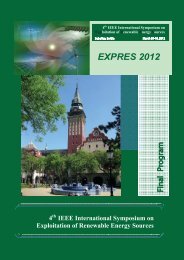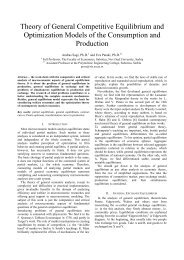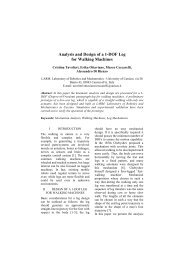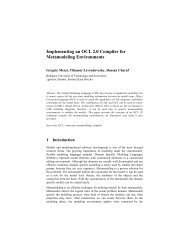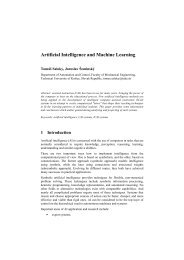Modeling and control of a 4-wheel skid-steering ... - University of Haifa
Modeling and control of a 4-wheel skid-steering ... - University of Haifa
Modeling and control of a 4-wheel skid-steering ... - University of Haifa
Create successful ePaper yourself
Turn your PDF publications into a flip-book with our unique Google optimized e-Paper software.
To calculate oscillator signal z d trapezoidal integration routine was used. In addition<br />
to ensure numerical stability <strong>of</strong> the algorithm scaling operation was performed to<br />
stabilized envelope <strong>of</strong> ‖z d ‖ determined by function δ d (t).<br />
Figure 7: Controller diagram<br />
Remark 6 It should be noted that implemented <strong>control</strong> scheme is based on assumption<br />
that longitudinal slip is negligible. In theory this assumption would not be<br />
necessary for overall <strong>control</strong>ler previously verified in simulation section.<br />
5.2 Results<br />
To validate the proposed simplified algorithm results <strong>of</strong> experiments are presented.<br />
Firstly, we considered the regulation problem, i.e. parking problem. The parameters<br />
<strong>of</strong> the <strong>control</strong>ler <strong>and</strong> initial conditions were presented in section 4, however ε 1 was<br />
increased to 0.05 to ensure better robustness <strong>and</strong> less sensitiveness to measurement<br />
noise.<br />
The results are depicted in Figs. 7(a)–7(b). From Fig. 7(a) one can see that steadystates<br />
position <strong>and</strong> orientation errors were bounded as follows<br />
∣ ˜X<br />
∣<br />
∣<br />
∣ < 20[mm], ∣Ỹ ∣ < 20[mm], ∣˜θ ∣ < 0.03[rad].<br />
In the next experiment trajectory tracking was verified. The reference trajectory was<br />
the same as it used in simulation <strong>and</strong> the parameter ε 1 was selected as ε 1 = 0.15<br />
to improve robustness <strong>of</strong> the <strong>control</strong>ler. From Fig. 8(a) <strong>and</strong> 8(b) one can see that<br />
accuracy <strong>of</strong> tracking is significantly less than accuracy obtained for regulation that<br />
results mainly from unmodeled dynamic effects (for example slip phenomenon) <strong>and</strong><br />
delays in the <strong>control</strong> loop. The tracking errors were bounded as<br />
∣ ˜X<br />
∣ < 80[mm],<br />
∣<br />
∣Ỹ<br />
∣ < 180[mm],<br />
∣<br />
∣˜θ ∣ < 0.3[rad].



